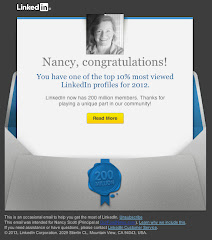 |
| Photo courtesy of Ardonik @Creative Commons |
In their early November podcast , Mark Schaefer and Tom Webster dissected the value of "personal branding."
Does everything we do (or don't do) -- on or off the social web -- end up creating our personal brand, like it or not? Should we care?
Mark says yes. Tom says no.
Check out their differing points of view.
Schaefer POV
• Today, we have the ability to create a reputation/image/brand through what we do, say, and write on the social web. Therefore, it's important to establish our reputation online to demonstrate our values, how we work, and how we think.
• A few years ago I had the opportunity to interview at a Fortune 500 company in NYC, but a friend of mine told me to be sure that I would be allowed to continue to work on my personal brand, even if I were employed by this company. I never thought of it that way before. In my experience, when you worked for a big company, you were subsumed by that company.
• Personal branding and authenticity go together. Tom has talked about how he is careful because he represents his company in some way. Like it or not, a certain "containment" or "formula" guides what we choose to present or not present on the web. That is part of our "brand."
• Marketing myself would never occur to me while I'm working for a company, but today that is probably a smart thing to do.
• What can an accountant, for example, do to become "known" for his brand? He/she could create a blog about new principles/regulations, which would create a brand. It's also about networking, speaking, and writing. He/she could become established on LinkedIn or other online networking tools to demonstrate, "This is whom I am, this is how I think."
• The brand you present can be commensurate with your experience. Even if it's not a lot of experience, you can show, "This is what I believe, this is what I read, this is who I know, this is what I am curious about, etcetera."
• Personal branding also involves being smart about building business relationships. You still have to connect person-to-person. Social media doesn't deliver business like personal relationships do.
• I would encourage marketers to think about personal branding strategically. Even if you are secure in your job today, think about creating a long-term online presence.
Webster POV
• In short, I'd say personal branding is a load of manure.
• Where does "brand" come from? It's where a product or company tries to give itself a personality. I already have a personality, which is a result of what I have done.
• To me personal brand was invented and discarded by Tom Peters 50 years ago in his book on 50 ways to build brand "you."
• Personal brand is not about spreading your fame. What is most important is that a group of my colleagues and clients believe that I will do what I say I will do.
• Your personal brand needs to take second place to the corporate brand. When Mark talks about developing "personal brand," he is talking about displaying your skill.. which makes him unique from, say, an accountant.
• To me personal branding is telling a story about yourself, not simply having an online presence. Networking, for example, is as old as the hills.
• I get that it's good to have things you own that demonstrate who you are: content and so on. The dark side of personal branding is that inexperienced people who do this, often demonstrate that they aren't very good. In other words, mere links, if they're weak, don't drive business.
• In the early phase of social web, you could be at the top if you were good at content marketing. However as the web matures, you also must be good at what you do, not just good at content marketing or how you present yourself.
Thank you, gentlemen, for a fascinating conversation that, we're sure, is to be continued ...
-- scrubbed by MarketingBrillo






